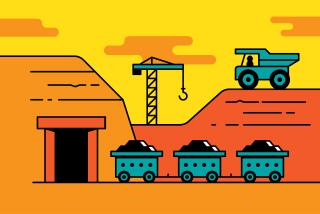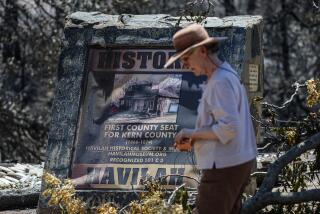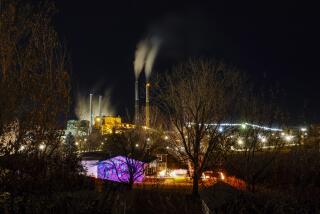Depopulated Coal Towns, Once Thriving, Head Toward Bottom
GARY, W.Va. — Anne Vineyard, surveying what’s left of her hometown for the past 54 years, says she can’t wait to join her neighbors and move on.
“It can’t get any worse than this,” says Vineyard, who is waiting for her youngest son to finish high school next year before she abandons Gary.
“I saw it go down, down, down. We’re at the bottom of the hill. We don’t have anything left for our children.”
Across the Appalachian coal fields, communities created by coal are dying, strangled by a paradox all too common in places such as Gary, Slab Fork and Tams.
Coal production keeps going up, but coal employment is plummeting.
As the jobs disappear, so do the towns that owed their existence to coal.
“Algoma, Worth, Ashland, McDowell, Crumpler. All these used to be thriving communities, but now there’s nothing left. It’s so sad,” says Mack Gillenwater, a geography professor at Marshall University who grew up in Crumpler in McDowell County.
In their heyday, these towns were islands of civilization in the rugged terrain of southern West Virginia. Some had schools, bowling alleys, theaters, restaurants and their own baseball teams.
Gary was created in 1971 by incorporating half a dozen villages in the hollows that stretch out like bony fingers south of Welch, the McDowell County seat, 100 miles south of Charleston.
The community, with 15,000 residents in 1940, had 27 churches, 10 company stores and three independent stores, three restaurants, nine elementary schools and two high schools, a clubhouse and even tennis courts.
Now it has a health clinic, a branch bank housed in a trailer, a combination grocery store and service station, and just 1,800 residents.
The town’s population has dropped 28% in the last decade. Its mammoth Alpheus coal preparation plant, described as the largest in the world when it was built 50 years ago, is being demolished.
The city’s street lights were turned off in the early 1980s because the municipal government couldn’t pay its electric bill.
Signs of decay also are apparent in Slab Fork, nestled in a hollow about 30 miles north in Raleigh County.
Once considered a model community, Slab Fork’s narrow streets were lined with company-owned houses, each surrounded by a white picket fence.
The Slab Fork Coal Co., run by the Caperton family, kept the homes neat and as late as the mid-1960s refurbished the interior of each house and installed modern gas furnaces.
But in 1983, Slab Fork Coal went bankrupt. The old company store burned to the ground. The processing plant was razed. A town that once had 210 houses now has about 30.
“There’s not much left of Slab Fork,” says 73-year-old Herman Martin, who was born in Slab Fork and worked for 40 years in the company store.
It’s too late for dozens of other coal towns that have disappeared. Just a few miles from Slab Fork were Tams and Big Stick. Tams had 1,250 residents in 1920, 500 in 1970, and nothing today but three abandoned houses and a church. Big Stick, once home to 300, has vanished completely.
“We’re losing our cultural heritage in Appalachia,” Gillenwater says.
In the coal industry, bad times always follow good. The cyclic nature of the business is legendary, and miners could always count on a slump to put them out of work until the next boom.
But over the years, each boom has meant fewer jobs than the time before.
Mechanization and faster, safer methods of mining coal have meant that production could increase even though employment didn’t.
Each time, more and more people have moved on, in the ‘50s and ‘60s to the mills and auto plants of the upper Midwest, in the ‘80s to the Carolinas and Texas.
West Virginia’s coal production increased from 121.5 million tons in 1980 to 152.5 million tons in 1989, but coal mine employment plunged during the same period from 55,502 to 24,600. Since the last big boom in the late 1970s, Appalachia has lost 100,000 coal mining jobs, the Appalachian Regional Commission says.
Fueled by migration toward Charlotte, N.C., along Interstate 77, dubbed the Hillbilly Highway, West Virginia’s population dropped more than any other state in the 1980s, down to 1.8 million.
In McDowell County, perhaps the hardest hit in West Virginia’s coal country, the population has plunged from about 100,000 in 1950 to less than half that today.
Until the 1970s, Gary was owned lock, stock and company store by U.S. Steel Corp. It was one of the last true company towns in West Virginia, with the company owning all the houses, the businesses and the land.
By 1971, U.S. Steel had sold the town to its residents, sometimes at bargain rates. People who had lived for years in a house found that they could own the property for a few thousand dollars. The communities incorporated as Gary, operated the county’s only sewage treatment system, burned street lights, hired as many as eight police officers.
The mines, supplying high-grade metallurgical coal to U.S. Steel’s mills in Gary, Ind., and Clarion, Pa., were running full-blast, always ready to hire more workers.
“They’d hire almost anybody off the street to mine coal,” Mayor Ron Estep recalls.
Then U.S. Steel, now known as USX, reacted to a national recession in the steel industry by shutting down its Gary mines and Alpheus preparation plant in 1982, idling 1,250 workers and creating a 90% unemployment rate. The mines reopened briefly in 1984, then shut down for good in 1986.
Since then, U.S. Steel has leased some of the coal seams it owns to small operators. One employs about 140 miners. Another announced its plans in mid-April to hire 40 miners--small consolation for a town that lost more than 1,000 jobs.
More to Read
Sign up for Essential California
The most important California stories and recommendations in your inbox every morning.
You may occasionally receive promotional content from the Los Angeles Times.










